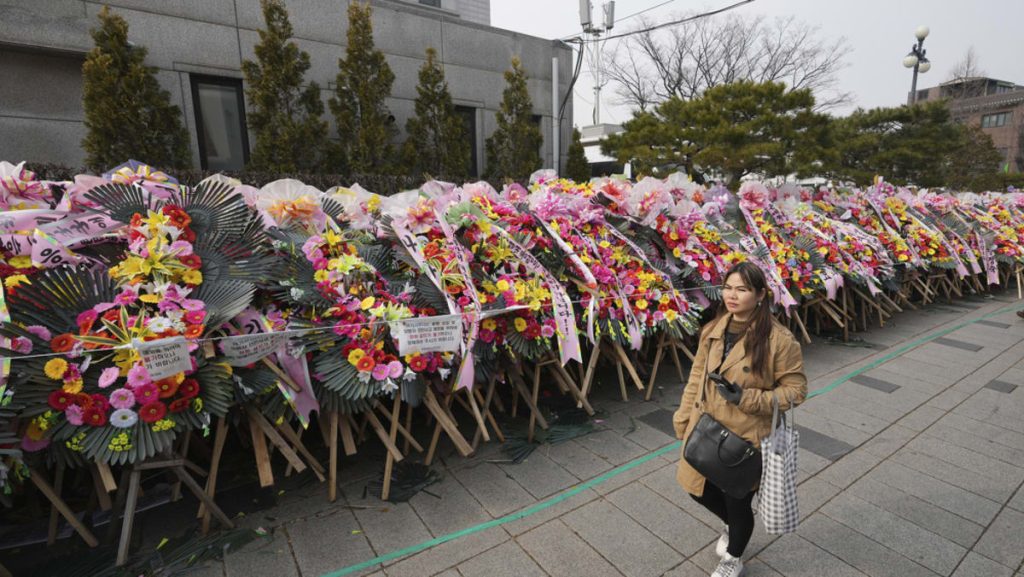The practice of sending funeral wreaths as a form of political protest has witnessed a significant surge in popularity in recent years, particularly in South Korea. This unconventional method of expressing dissent has captured media attention, with coverage increasing fourfold in 2024 compared to the previous year, according to data analysis from Big Kinds, a news aggregator tracking over 100 local outlets. While the exact origins of this protest method remain elusive, news reports suggest its emergence in the early 2010s. The increasing visibility of wreath protests suggests a growing adoption of this tactic by certain political factions, transforming the traditional symbol of mourning into a tool for political expression.
While many florists claim unfamiliarity with protest-related wreath orders, and some online platforms actively promote politically neutral wreath sales, certain flower shops have emerged as hubs for this burgeoning movement. Dongsung Flower, a Seoul-based florist, has become a prominent supplier for pro-government supporters, having delivered over a thousand wreaths since December. Yoon Miyoung, the owner, notes a remarkable demand, claiming Seoul’s flower supply is being strained by the sheer volume of orders. This surge in demand reveals not only the growing popularity of the protest method but also its potential economic impact on the local flower market. Interestingly, a significant portion of Dongsung Flower’s clientele consists of younger individuals in their 20s and 30s, with orders even originating from international locations like Japan, the United States, and the Netherlands, highlighting the transnational reach of this unique form of protest.
The adaptability of the wreath as a protest tool is evident in the evolving messages and flower choices employed. Although the fundamental format remains consistent, the specific flowers used and the messages displayed on the ribbons reflect the nuances of each protest. This customization allows protestors to tailor their message to specific targets and issues, offering a degree of personalization rarely seen in traditional protest methods like marches or rallies. While this personalization allows for targeted messaging, it also raises concerns about the potential for escalating rhetoric and targeted harassment.
While the visual impact of numerous wreaths lining the streets or surrounding government buildings can be striking, the underlying message conveyed through these floral displays has become increasingly controversial. Professor Choi Hang-sub of Kookmin University observes that while wreath protests avoid physical violence, the messages accompanying them have evolved into a form of offline hate speech, mirroring the toxicity often found in online comments sections. This evolution raises important questions about the boundaries of free speech and the potential for this protest method to devolve into harassment and intimidation. The transition from a symbolic expression of dissent to a potentially harmful form of public shaming is a key concern surrounding this evolving protest tactic.
Despite the growing media attention and the increasing volume of orders, the efficacy and broader societal acceptance of wreath protests remain uncertain. Professor Kim Hern Sik of Jungwon University argues that these protests remain an isolated form of demonstration, largely confined to specific political groups. This limited adoption hinders its potential to gain wider public support and influence broader political discourse. While visually striking, the wreath protest’s impact may be confined to specific segments of the population, limiting its potential for widespread social change.
In conclusion, the rise of wreath protests in South Korea represents a fascinating evolution in political activism. While its visual impact and growing media coverage are undeniable, several key questions remain. Can this form of protest transcend its current niche status and gain broader societal acceptance? Will its association with targeted harassment and online hate speech ultimately undermine its legitimacy? And how will authorities and society at large grapple with the evolving messages and potential for escalating rhetoric embedded within this increasingly popular form of political expression? The future trajectory of wreath protests will depend on how these complex questions are addressed.

